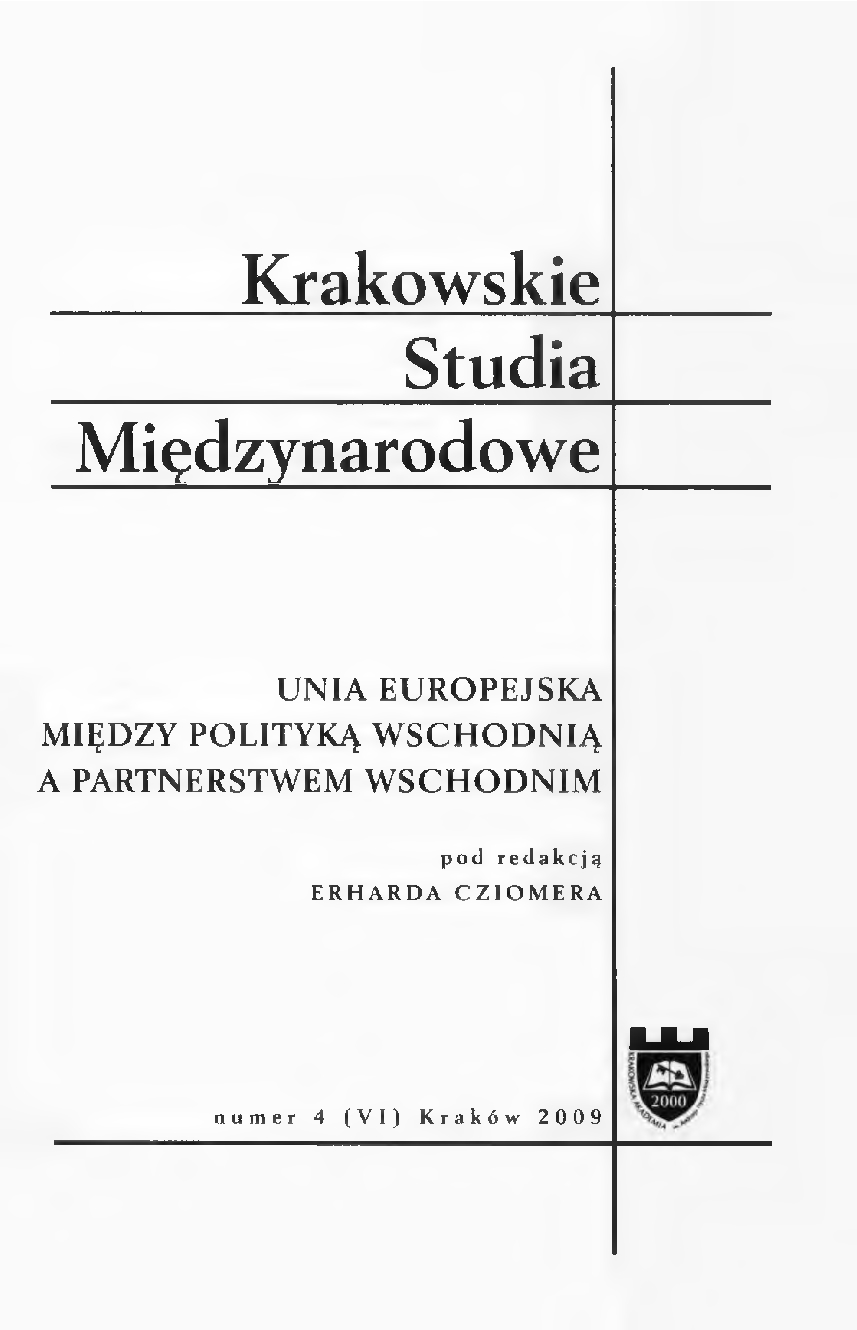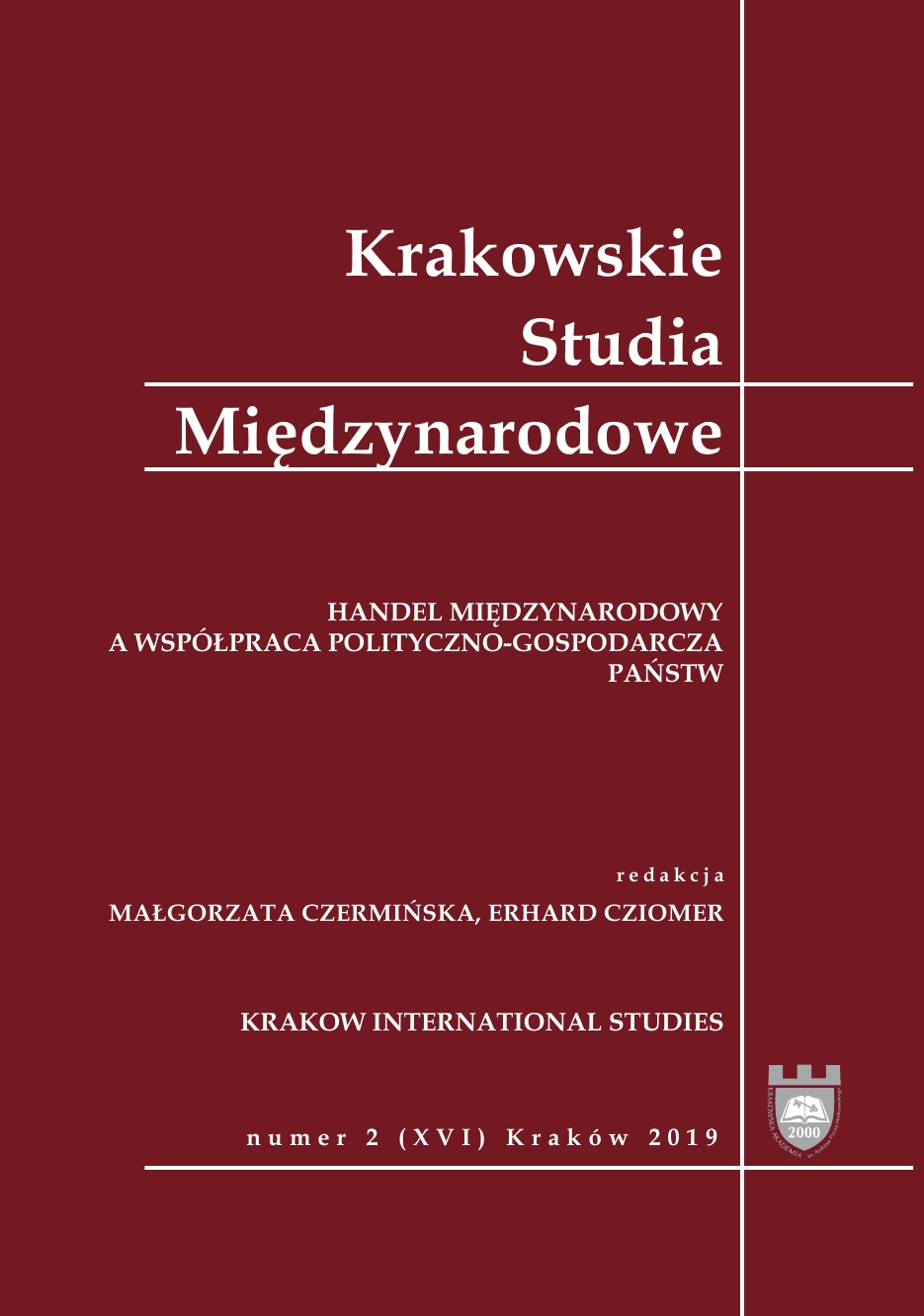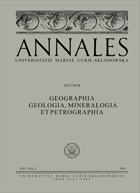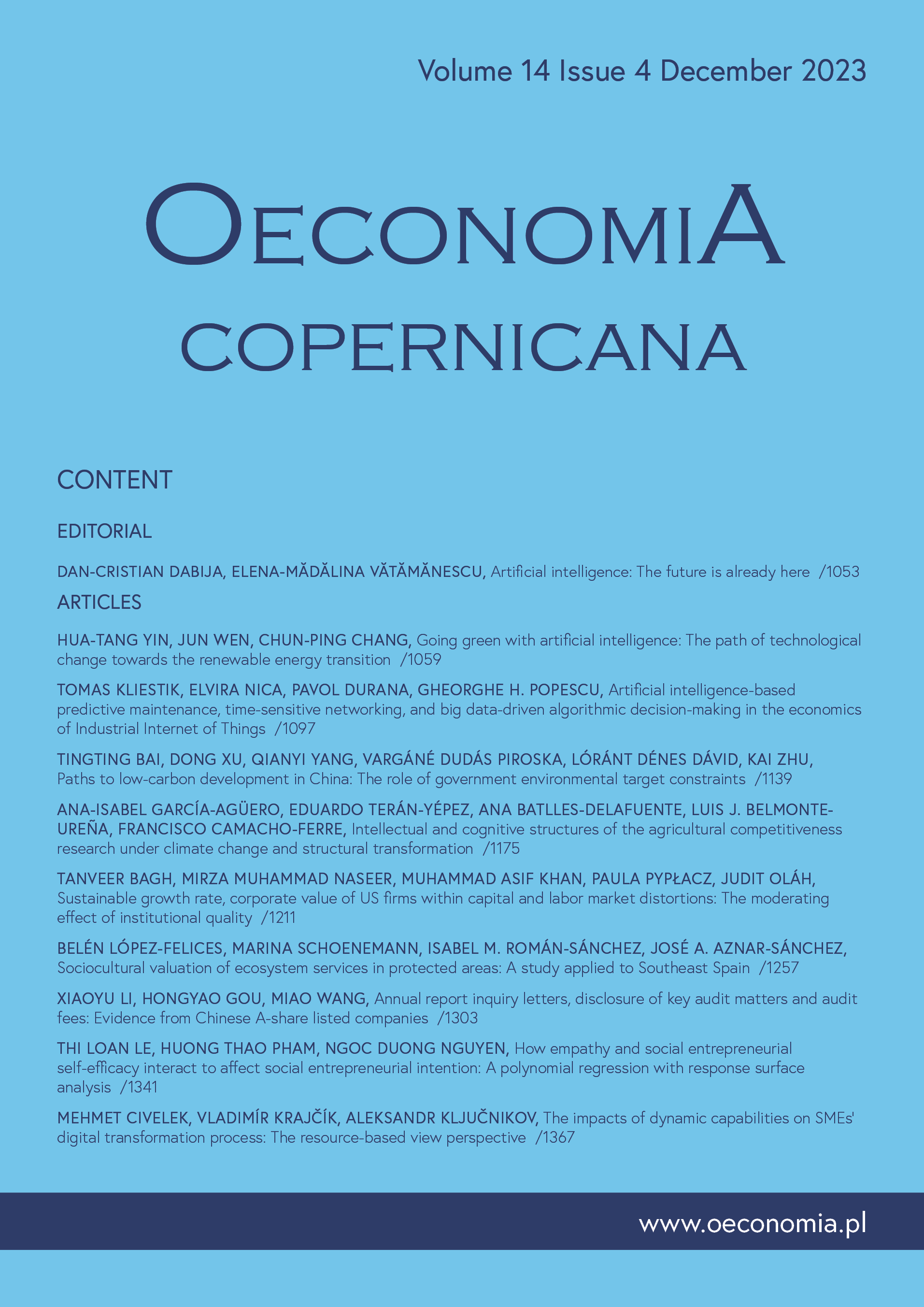
We kindly inform you that, as long as the subject affiliation of our 300.000+ articles is in progress, you might get unsufficient or no results on your third level or second level search. In this case, please broaden your search criteria.



The article presents selected issues of energy cooperation between Morocco and Germany. The starting point of the considerations are data on the Moroccan energy situation as well as assumptions and objectives of Morocco’s energy policy in the 21 st century. In addition, the study presents the causes and development of bilateral energy cooperation, including in particular manifestations of Germany’s involvement in the process of creating and achieving Morocco’s energy policy goals. It discusses the essence of the energy partnership of Morocco and Germany, as well as selected examples of Moroccan projects co-financed by German institutions in the field of renewable energy development and increasing energy efficiency.
More...
The paper argues that nuclear energy could play a significant role in decarbonizing the production of low carbon hydrogen from natural gas feedstock with associated carbon storage, as part of a wider shift towards ‘net-zero’ in Canada’s natural resources value chain. It examines regulatory readiness for small modular reactors in the oil, gas, and low-carbon energy sector of Canada’s energy jurisdiction, and calls for the speedy design and development of a single ‘go-to’ regulatory framework for nuclear energy in Alberta.
More...
This article pertains to the role of law in regulating the energy market. Justice and solidarity in this area require a debate that should not be fragmented but must, instead, take place in an interdisciplinary manner. The key question that arises relates to the role that the law should play in the area of energy transformation, and thus, whether it should only be a tool for the implementation of political plans and action strategies, or whether it should, in itself, stimulate or determine the transition framework, or be a regulator of transformation. The article tackles selected problems related to Demand Side Management (DSM), de-growth, energy poverty, Not In My Back Yard (NIMBY) initiatives and Contracts for Differences (CfD), in order to call for interdisciplinary research and cooperation in this context.
More...
The purpose of this article is to investigate the species composition, age structure, and economic utilization of forest plantations in the Busk forestry. The practical importance of such research increases in the context of administrative reform and land resource management in newly created communities and announced consolidations of forestry enterprises in 2021. The research used various time-based cartographic materials, which allowed to trace the development of typical forest massifs from the end of the 18th century to the present day. The study was conducted for four time periods. The proposed study was carried out by processing statistical materials of the Busk forestry. Based on this data, cartographic schemes of species composition, age structure, and timber stock were constructed and analyzed by forestry. It was established that the characteristic features of forestry in the region are: uneven forest cover of the studied territory; significant fragmentation of the forest fund in the southern part of the forestry territory; location of large forest massifs in the northwestern part of the forestry; dominance of such tree species as pine, oak, and alder in the forest stands; insignificant increase in forest cover in individual territories due to the creation of pine tree cultures on unproductive lands and active expansion of black alder forests in over-moistened pastures. The division of the forest fund into categories has been studied. It has been established that the largest share of the forest fund of the Busk forestry is occupied by exploitable forests. Protective forests account for 1.5% of the total forest area in the studied region. The forest supply per capita in the Krasne territorial community is on average 0.12 ha/person, while in Busk it is 0.61 ha/person.
More...
The purpose of the publication is to indicate potentially important areas for the presence of the Eurasian lynx (Lynx lynx) within the Transcarpathian region in Ukraine using GIS modeling tools to optimize the network of protected areas. The modeling consisted of a preliminary analysis of the following five parameters that are important for the life of the species: type of land cover, proximity of non-forest biotopes to forest biotopes, high-altitude bioclimatic zones, degrees of relief dissection, distance from settlements and roads. A comprehensive GIS analysis of these pa- rameters made it possible to establish that the total area of territories that are potentially suitable for the presence of the Eurasian lynx within the Transcarpathian region is 192.6 thousand hectares, and covers about 9.9% of the territory of the region. The most suitable areas are concentrated in the mountainous southeastern part of the region within the orographic ecoregion of the elevated dissected highlands. Within the modeled habitats, there are often places where real signs of the species’ distribution have been recorded. In the second stage of the research, a cartographic model “Territories of the potential presence of the Eurasian lynx (Lynx lynx) and key areas of the regional ecological network of the Transcarpathian region” was obtained, where population, reproduction and other areas, as well as the degree of nature protection in these areas, were established.
More...
The article examines the essence of the European Strategy for the Conservation of Landscape and Biotic Diversity, the principles of formation, conservation and use of eco-networks in Ukraine, the existing problems of national and regional networks, taking into account the new administrative-territorial structure at the administrative-district level and the level of territorial communities. The purpose of the article is to assess the functional and territorial structure of the protected and ecological networks of Ternopil region and to substantiate the ways of their opti- mization in modern conditions. The paper is based on the information obtained in the course of field expeditionary research in 2019–2022, as well as on statistical data, cartographic materials, and materials from the open network of aerospace satellite images Google Earth. The collectedmaterials were processed using a system of methods (analysis, synthesis, comparison, decoding, cartographic, computer modeling, etc.). The data obtained showed that in 36.5% of the territorial communities, protected areas cover less than 1%. In order to improve the situation, the authors propose the creation of 53 new protected areas in 25 communities of Ternopil region with a total area of 39,358 hectares and substantiate the new core and connecting territories of the local rank of the regional eco-network.
More...
Research background: To achieve the targets for carbon peak and air quality improvement, local governments should propose environmental targets and develop realization paths that are tailored to their unique local conditions. They then promote low-carbon development through the implementation of multiple measures.Purpose of the article: As the government performance appraisal system im-proves, the ques- tion arises as to whether governments take the initiative to com-bine environmental policies with government target constraints to reduce carbon emissions.Methods: The announcement of environmental target constraints by local governments in government work reports is considered a quasi-natural experiment. This study examines the effect of government environmental target constraints (GETC) on carbon emissions (CEs) using differences-in-differences (DID), propensity score matching-DID (PSM-DID), and spa- tial-DID (SDID) with data from 241 Chinese cities from 2003 to 2019.Findings & value added: The results demonstrate that GETC can effectively reduce local CEs, with the inhibitory effect being most effective in the first two years after setting environmental targets, but diminishing in the third year. GETC can reduce local CEs through three paths: reducing energy consumption, promoting industrial structure optimization, and encouraging green technology innovation. Spatial spillover effects show that GETC reduces local CEs while exacerbating CEs in neighboring cities, indicating a beggar-thy-neighbor effect in conventional environmental regulation policy. This effect is observed mainly in the geographic matrix and the economic-geographic matrix, but not in the economic matrix. According to heterogeneity analysis, GETC in the eastern and central cities can significantly reduce CEs. The inhibitory effect of GETC on local CEs is stronger in cities where secretaries and mayors have longer tenures and higher levels of education. The paper's theoretical value lies in exploring the reduction of CEs through the combination of government self-restraint and environmental policies, providing a new solution for local governments to achieve CEs reduction. Further- more, it offers practical insights into the improvement of the Chinese government assessment system.
More...
This article discusses the evolution of the energy security of Belarus, Estonia, Latvia, Lithuania, Poland and Ukraine since the collapse of the Union of Soviet Socialist Republics (USSR), in terms of natural gas supplies. Instead of framing energy dependencies on Russia in a descriptive way, this article shows the empirical validation of the Falin–Kvitsinsky doctrine, which includes the use of energy resources as tool in foreign policy. Therefore, the authors propose a three-element Falin–Kvitsinsky doctrine indicator to measure the power of this doctrine using the yearly data for 1991–2021. Authors argue that the impact of this doctrine should be assessed through the lens of energy supply security and then measured by appropriate indicators. This approach might be seen as opposite to the mainstream publications which are mostly descriptive in this field. In the article, the authors provided clear evidence of the Falin–Kvitsinsky doctrine existence until the end of 2021, which was applied during the Russian-Ukrainian war. Actions taken by Russia over the years were aimed at making Central European countries dependent on natural gas supply, which would then prompt these countries to limit their aid to Ukraine during the conflict that began in 2022. In conclusion, Russia is able to pursue its political goals in the manner suggested by the Falin–Kvitsinsky doctrine as long as each Central European country tries to ensure its own energy security. However, the Falin-Kvitsky doctrine did not fully meet its objectives, as Central European countries, as a result of the Russian-Ukrainian war, were able to quickly take steps to diversify the sources and directions of natural gas supplies by taking comprehensive measures and strengthening cooperation.
More...
This study investigates the impact of renewable (REW) andnon-renewable (NREW) energy usage, along with econom-ic growth (GDP), on carbon dioxide (CO2) emissions in theVisegrad countries, which rely heavily on traditional energysources. Using data from 1991 to 2021, the analysis employsa panel asymmetric regression with Driscoll-Kraay and FGLSstandard errors. The latent cointegration test reveals long-term relationships with asymmetry among the variables.Real GDP fluctuations exhibit a negative impact on CO2emissions for both positive and negative shocks. A reduc-tion in conventional energy source consumption leads toa greater CO2 emission reduction, confirming asymmetry.Conversely, an increase in consumption positively impactsCO2 reduction. However, non-conventional energy sourcesshow no asymmetries. The OLS-based model proposed byDriscoll-Kraay showed reduced standard errors, but lowersignificance in the estimated parameters compared to theFGLS model. The findings recommend a sustainable energytransition for Visegrad countries by eliminating traditionalsources and promoting renewable resources.
More...
In recent years, the People’s Republic of China (PRC) has pursued an increasingly active climate and energy policy at both the national and international level. The increased interest in environmental issues is reflected in the declarations that have been made and the investments that have been undertaken. The Chinese government is aware that the fight against climate change is crucial to ensure the security and well‑being of society. In this article, the author will present the measures taken by the PRC and indicate their impact on shaping security in the country.
More...
The aim of this study is to assess the relationships between the main stakeholders involved in watermanagement in Sidi Bel Abbes city (western Algeria) to establish pathways for good governance, fairallocation and sustainability of water resources. A multi-stakeholder analysis was performed using theMACTOR method (method of actors and power relations) to analyze stakeholder strategies, alliances,and potential conflicts regarding water management. Data for the study were collected mainly duringmulti-stakeholder workshops with 6 main stakeholders who are directly involved in managingpotable water. A field survey of 329 local households was conducted with the use of supplementaryquestionnaires. This study proposes that the power dynamics among actors should be consideredduring the decision-making process to improve collaborative interactions and the effectiveness ofstakeholders engaged in water management. The research findings show that the stakeholder’s roles andstrategies should be coordinated and strengthened to ensure equitable allocation of water. Technicalpublic agencies deploy management strategies that do not consider water quality as a priority, and theyare more concerned with other strategic objectives. Additionally, the stakeholders disagree on manyissues relating to water management due to overlapping and conflicting powers, which threatens thequality and availability of water resources. The study also demonstrated that the National SanitationOffice could play an important role as a relay stakeholder and that the Hydrographic Basins Agencyshould strengthen alliances and commitments with all stakeholders. Enhancing the participationof these stakeholders in water management procedures and empowering domestic water end users,particularly in densely populated residential areas, could help bridge divides and foster a unifiedapproach to achieving sustainable water management objectives.
More...
This paper proposes methods for assessing the potential of local strategies and pro- grammes as practical tools to evaluate their effectiveness in the fields of energy and energy efficiency. By employing these methods, local communities and spe- cific energy cities can determine the level of compliance of their strategies or pro- grammes with legislative and regulatory acts at both national and regional levels. This assessment of local strategies and programmes aims to establish an organised system and represents a significant step towards the implementation of energy effi- ciency and sustainability practices.The paper conducts an analysis of strategies and programmes in six local communities across six regions (oblasts) of Ukraine using the suggested methods. This approach allows for a comprehensive analysis of different regions in Ukraine, and the findings will be presented in the conclusions.The practical implications of the findings presented in this paper may be of interest to energy companies, local self-government authorities, utility com- panies, academia, and a broader audience concerned with energy and energy effi- ciency issues. While the methods are applied and tested using Ukrainian com- munities as examples, they serve as a valuable model that can be adapted for use in territorial units across various countries.
More...
Motivation: In the face of contemporary environmental and economic challenges, a tran- sition to more sustainable global plastics economy is crucial. Countries are implementing circular economy solutions, but one of the common problems is so called “waste tour- ism” — export of plastic waste to other countries, often less developed. It contributes to global environmental problems but frequently surfaces also as inefficient resource management/trade and an ethical question as well. Transboundary movements of plastic waste from EU countries should be based on the principles set out in the Basel Conven- tion which entail minimizing and disposing all kind of waste in an environmentally sound manner, minimizing the amount of waste transported and treating and disposing it as close as possible to its place of origin. Unfortunately, European plastic waste is exported in large quantities, often to less developed countries and not processed in accordance with European standards. Aim: This paper aims to identify the volume and directions of UE countries export patterns of plastic waste, its impact on the Sustainable Development Goals and trends in global and EU rules on transboundary plastic waste movements. The considerations are based, to a great extent, on literature on the subject-matter and secondary data, i.e. export data under the trade code 3915 (Waste, pairings and scrap of plastics) derived from the UN Comtrade and Eurostat Database, SDGs data derived from Sustainable Devel- opment Report 2022 and UN database and main legal basis for the international trade in plastic waste (the Basel Convention with its recent amendments) and its trends.Results: EU countries are still the leaders in exporting plastic waste, making it difficult to achieve the 12th SDG. Changes to the Basel Convention have not significantly affected the volume and destinations of EU plastic waste exports. They organize the categories of plastic waste but still leave an ample room for undesirable activities. Although the EU’s proposals are more restrictive, the most desirable solution is a complete ban on the export of plastic waste by EU countries outside the EU.
More...
The aim of the article is to assess the spatial diversity of the area structure of organic farms in Poland at the level of regions and communes, along with identifying the direction and pace of changes in 2012–2021. The basis for the study was data from the General Inspectorate of Trade Quality of Agricultural and Food Products (GIJHARS). Current trends and changes taking place in the size structure of organic farms are presented and described. It was found that their average area was 27.5 ha and varied at the regional level, from less than 15 ha in the province. Lublin, Lesser Po-land and Podkarpackie, to over 40 ha in the Lower Silesia, Lubusz, Pomerania and West Pomerania. In the years 2012–2021, the average area of an organic farm in Poland increased by 2 ha (from 25.5 to 27.5 ha; an increase of 7.8 percentage points), i.e. 0.2 ha on average per year. It should be noted that in the same period, the average area of a traditional farm increased by 0.82 ha (from 10.38 to 11.20 ha in 2021; average annual increase – 0.09 ha), which indicates a much more intense growth rate of organic farms.It was found that the spatial arrangement of the processes of changes in the size structure of organic farms is very similar and constitutes an integral part of the size changes of all farms. However, a sig-nificant number of communes in which organic farms started or ended their operations in the organic production system during the period under study may indicate that organic farming is a phenomenon that is still developing its spatial structure. This, in turn, indicates the need for further research and monitoring of spatial phenomena related to organic farming, especially taking into account EU obli-gations and the increasing importance of this form of agricultural activity
More...
The aim of the paper is to present Germany’s position during the government of Chancellor Angela Merkel (CDU/CSU/SPD coalition: 2018-2021) and Chancellor Olaf Scholz (SPD/Alliance 90/Greens/FDP coalition: from 2021) towards changes in climate policy (understood as reform) introduced by the European Green Deal and the Fit for 55 package of legislative proposals, with particular emphasis on the issue of CO2 emission standards for new passenger cars and new light commercial vehicles. Germany’s support for increasing the level of ambition in the field of climate protection in the EU was largely the result of the belief that the success of the German transformation of the energy sector and achieving climate neutrality by 2045 also depends on the progress of the energy transformation process and the climate neutrality policy in the European Union.
More...
The research aim of the paper is to analyze the objectives of the European Union (EU) climate policy and the instruments for their implementation, as well as to present the challenges on the way to achieving climate neutrality by the EU. In 2015, during the 21st UN Climate Change Conference in Paris, an agreement was agreed, the purpose of which is to limit global warming, aiming, among other things, for limiting the increase in global average temperature to well below 2°C above pre-industrial levels, and preferably to no more than 1.5°C. All EU Member States have ratified the above agreement, while agreeing to take action to make the EU the world’s first climate-neutral economy and society by 2050. To achieve this, the “European Green Deal” strategy was adopted, followed by the European Climate Law and the “Fit for 55” package of legislative proposals. In addition, a more ambitious EU climate target for 2030 has been agreed, namely a reduction of net greenhouse gas emissions by at least 55% compared to 1990 levels. Based on this, the following research hypothesis should be put forward, assuming that if all initiated projects, climate programs and mechanisms are fully implemented, the EU will become the first climate neutral continent by 2050. The first part of the article focuses on the goals of the European Green Deal and their implementation. The second part discusses the assumptions of European Climate Law and the elements of the “Fit for 55” package, as well as presents the most important financial instruments of the EU climate policy. The third part contains an analysis of the challenges standing in the way of the EU achieving climate neutrality by 2050, including the COVID-19 pandemic and the Russian aggression against Ukraine.
More...
The article aims to present the role Russian crude oil and natural gas play in Belarus’ economy, and is based on content analysis and comparative method. The analysis covers the years 2010-2021 and discusses statistical data on Russian-Belarusian cooperation regarding oil and gas. The article analyzes the amount of Russian energy support for the Belarusian economy. After 2015, Russia initiated the process of optimizing further support for Belarus. The restriction on the volume of Russian oil transmitted to Belarus will translate into a 2-3 drop in Belarusian GDP. The import of oil from Russia will decrase even by 60%, which will minimize Belarusʼ profits from oil export. In the coming years Belarus will remain almost entirely depended on Russian gas and oil.
More...
This paper identifies the extent of airpollution in motivating companies to implementenvironmental management accounting (EMA)practices in 67 mining and cement companies listedon the Johannesburg Stock Exchange (JSE), SouthAfrica, from 2012 to 2021. Pooled ordinary leastsquares regression is applied to analyse the data.EMA is proxied by environmental training,environmental audits and energy efficiency, while airpollution is measured based on the air quality index(AQI). The results show that air pollution is essentialfor companies to adopt EMA practices. This meansthat when air quality declines within a company’slocality, a company proactively adopts EMApractices. This suggests that air pollution is a keybasis of companies' adoption of EMA, as predicted bythe legitimacy theory. The study includes threecontrol variables: size, return on assets (ROA) andnumber of years listed on JSE. Two control variables,namely Size and ROA, portray a positive andsignificant effect on adopting EMA from air pollution.This portrays that a financially stable company tendsto submit to air pollution and use EMA to counter thepollution. In contrast, as the number of yearsincreases for companies listed on JSE, EMA will likelybe adopted less to reduce air pollution.
More...